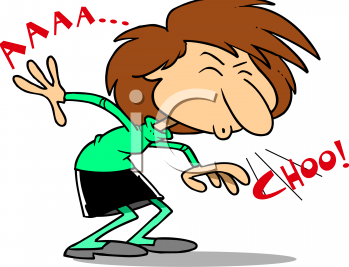PLEASE SNEEZE ON MY CHILD

Please Sneeze on My Child was actually the title of an article published in the New England Journal of Medicine (NEJM) August 24, 2000. Sometime in our past, our society has learned to frown on the very necessary natural sneeze.
The purpose of the sneeze is to expel foreign matter and to activate your sinuses and all the other components of your upper respiratory system to come to the aid of your immune system as it reacts to some invader. The invader may be dust or a virus or some particulate, and a sneeze is meant to throw the invader out at the incredible speed of almost 90 mph. Pretty fast!
When your child sneezes or other children sneeze around him or her your child is being exposed to some of the best natural vaccinations possible. We are talking about minor immune challenges that can build an appropriate immune response in the future. The occasional cold or flu is not an illness (it is an expression of health), and a chance to exercise their immune system.
If you are a parent that completely isolates your child from bugs and critters carried around by other kids they come in contact with, you may be crippling them in terms of gaining the immunity they need to be healthy in the many situations they find themselves in throughout the course of their life.
If you don’t exercise and move around or just stay still all day your muscles will atrophy. If you don’t huff and puff once and a while you exercise your lungs actually lose the capacity to efficiently supply your body with oxygen when you need it. In other words: USE IT OR LOSE IT.
In the article above “Please Sneeze on My Child” it was stated that the more your children are exposed to virus or bacteria (antigens) at a young age and the less we interfere with the natural immune response there is less of a chance of them getting allergies or asthma into adulthood. This is contrary to what most of us have been taught and do.
Benefits of fever
1.At 102 degrees Interferon, which are proteins that prevent viral replication and inhibit cancer, cells are activated. 2.At 103 degrees all nutrition stored to spleen to starve bacteria. Above 103 bacteria causing infection begin to die because they lack food. 3.Fevers are the second line of defense after skin, mucous membranes, tears, and urine. A fever is a sign of a healthy immune response. 4.Duke University states many studies are suggesting that these anti-fever agents may actually reduce the body’s immune response against cold and flu viruses and prolong symptoms. A 2000 study, for example, reported longer flu duration in people who took aspirin or acetaminophen.
THE NUMBER ONE, MOST IMPORTANT FACTOR IN COMBATTING ANY UNWANTED INVADER IS A STRONG IMMUNE SYSTEM.
Fever – Myths and Facts
Misconceptions about the dangers of fever are commonplace. Let the following facts help you put fever into perspective: MYTH: All fevers are bad. FACT: Fevers turn on the body’s immune system. Fevers are one of the body’s protective mechanisms. Myth: Fevers cause brain damage or fevers over 104F (40C) are dangerous. Fact: Fevers with infections don’t cause brain damage. Only body temperatures over 108F (42C) can cause brain damage. The body temperature goes this high only with high environmental temperatures (for example, if a child is confined in a closed car in hot weather). MYTH: Anyone can have a febrile seizure (seizure triggered by fever). FACT: Only 4% of children have febrile seizures. MYTH: Febrile seizures are harmful. FACT: Febrile seizures are scary to watch, but they usually stop within 5 minutes. They cause no permanent harm. Children who have had febrile seizures do not have a greater risk for developmental delays, learning disabilities, or seizures without fever. MYTH: Without treatment, fevers will keep going higher. FACT: Wrong. Because of the brain’s thermostat, fevers from infection top out at 105F or 106F (40.6C or 41.1C) or lower. MYTH: Temperatures between 98.7F and 100F (37.1C to 37.8C) are low-grade fevers. FACT: The normal temperature changes throughout the day. It peaks in the late afternoon and evening. A low-grade fever is 100F to 102F (37.8C to 39C).
‹ Back




Comments